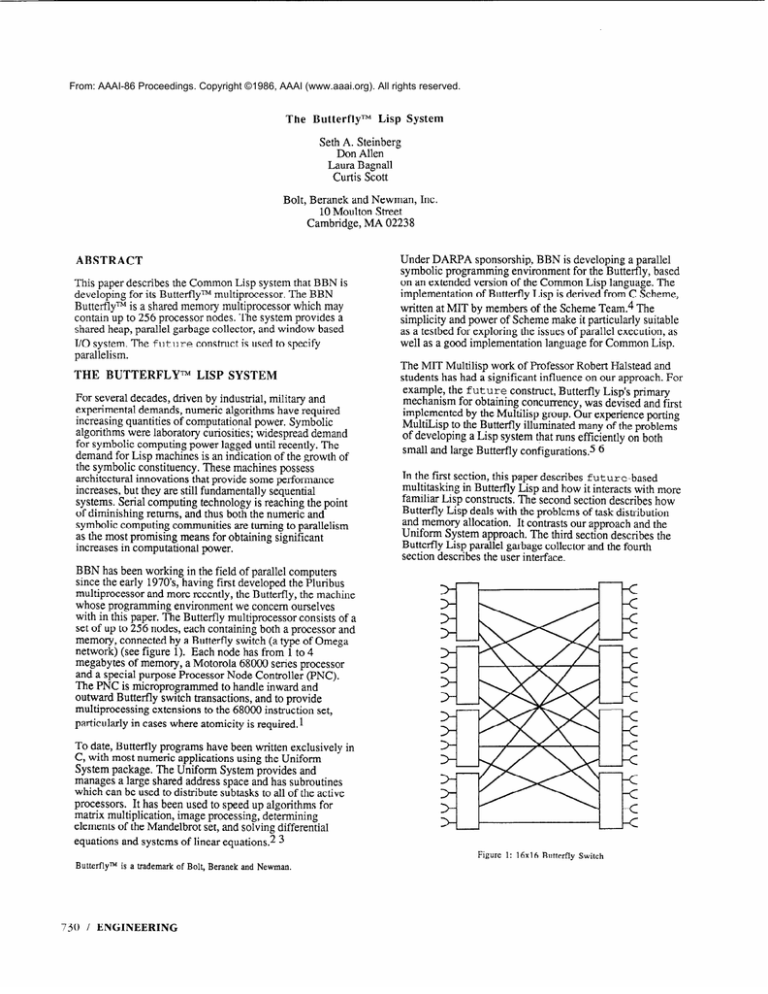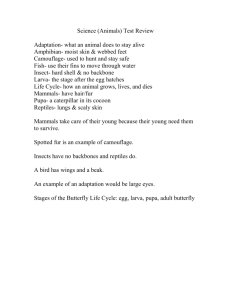
From: AAAI-86 Proceedings. Copyright ©1986, AAAI (www.aaai.org). All rights reserved.
The Butterfly TMLisp System
Seth A. Steinberg
Don Allen
Laura B agnall
Curtis Scott
Bolt, Beranek and Newman, Inc.
10 Moulton Street
Cambridge, MA 02238
ABSTRACT
This paper describes the Common Lisp system that BBN is
developing for its ButterflyTM multiprocessor. The BBN
ButterflyTM is a shared memory multiprocessor which may
contain up to 256 processor nodes. The system provides a
shared heap, parallel garbage collector, and window based
I/Osystem.
The future construct
is used to specify
parallelism.
THE BUTTERFLYTM LISP SYSTEM
For several decades, driven by industrial, military and
experimental demands, numeric algorithms have required
increasing quantities of computational power. Symbolic
algorithms were laboratory curiosities; widespread demand
for symbolic computing power lagged until recently. The
demand for Lisp machines is an indication of the growth of
the symbolic constituency. These machines possess
architectural innovations that provide some performance
increases, but they are still fundamentally sequential
systems. Serial computing technology is reaching the point
of diminishing returns, and thus both the numeric and
symbolic computing communities are turning to parallelism
as the most promising means for obtaining significant
increases in computational power.
Under DARPA sponsorship, BBN is developing a parallel
symbolic programming environment for the Butterfly, based
on an extended version of the Common Lisp language. The
implementation of Butterfly Lisp is derived from C Scheme,
written at MIT by members of the Scheme Team.4 The
simplicity and power of Scheme make it particularly suitable
as a testbed for exploring the issues of parallel execution, as
well as a good implementation language for Common Lisp.
The MIT Multilisp work of Professor Robert Halstead and
students has had a significant influence on our approach. For
example, the future construct, Butterfly Lisp’s primary
mechanism for obtaining concurrency, was devised and first
implemented by the Multilisp group. Our experience porting
MultiLisp to the Butterfly illuminated many of the problems
of developing a Lisp system that runs efficiently on both
small and large Butterfly configurations.5 6
In the first section, this paper describes future-based
multitasking in Butterfly Lisp and how it interacts with more
familiar Lisp constructs. The second section describes how
Butterfly Lisp deals with the problems of task distribution
and memory allocation. It contrasts our approach and the
Uniform System approach. The third section describes the
Butterfly Lisp parallel garbage collector and the fourth
section describes the user interface.
BBN has been working in the field of parallel computers
since the early 1970’s, having first developed the Pluribus
multiprocessor and more recently, the Butterfly, the machine
whose programming environment we concern ourselves
with in this paper. The Butterfly multiprocessor consists of a
set of up to 256 nodes, each containing both a processor and
memory, connected by a Butterfly switch (a type of Omega
network) (see figure 1). Each node has from 1 to 4
megabytes of memory, a Motorola 68000 series processor
and a special purpose Processor Node Controller (PNC).
The PNC is microprogrammed to handle inward and
outward Butterfly switch transactions, and to provide
multiprocessing extensions to the 68000 instruction set,
particularly in cases where atomicity is required.1
To date, Butterfly programs have been written exclusively in
C, with most numeric applications using the Uniform
System package. The Uniform System provides and
manages a large shared address space and has subroutines
which can be used to distribute subtasks to all of the active
processors. It has been used to speed up algorithms for
matrix multiplication, image processing, determining
elements of the Mandelbrot set, and solving differential
equations and systems of linear equations.2 3
Figure 1:
Butterflym
is a trademark of Bolt, Beranek and Newman.
730 / ENGINEERING
16x16 Butterfly
Switch
BUTTERFLY
LISP
Experiments in producing parallel programs that effectively
use the available processing power suggest that the
fundamental task unit must execute on the order of no more
than lOO-1000 instructions 7 8 9. If the task unit is larger,
there will be insufficient parallelism in the program. This
task size is only slightly larger than the size of the typical
subroutine. This similarity in scale implies that the tasking
overhead must be within an order of magnitude of the
subroutine overhead. To encourage the programmer to use
subtasks instead of calls, the tasking syntax should be
similar to the calling syntax.
Butterfly Lisp uses the future mechanism as its basic task
creating construct. The expression:
(future
mapcar does not return until all of the subtasks have been
spawned. We can create the futures more aggressively,
as in the following example:
(defun
aggressive-mapcar
(function
list)
(if (null list)
nil
(cons (future (function
(car list)))
(future (aggressive-mapcar
function
(cdr list))))))
A call to aggressive-mapcar
would quickly start two
subtasks and immediately return a cons containing the two
futures.This makes it possible to start using the result of
the subroutine well before the computation has been
completed.Ifapairof
aggressive-mapcars is
cascaded:
<s-expression>)
causes the system to note that a request has been made for
the evaluation of <s-expression>, which can be any
Lisp expression. Having noted the request (and perhaps
begun its computation, if resources are available), control
returns immediately to the caller of future,returning a
new type of Lisp object called an “undetermined future” or
simply,a future.The future object serves as a
placeholder for the ultimate value of <s-expression>
and may be manipulated as if it were an ordinary Lisp object.
It may be stored as the value of a symbol, consed into a list,
passed as an argument to a function, etc. If, however, it is
subjected to an operation that requires the value of <sexpression> prior to its arrival, that operation will
automatically be suspended until the value becomes
available.
future provides an elegant abstraction for the
synchronization required between the producer and
consumer of a value. This permits results of parallel
evaluations to be manipulated without explicit
synchronization. Thus, Butterfly Lisp programs tend to be
quite similar to their sequential counterparts.
(aggressive-mapcar
f
(aggressive-mapcar
subtasks spawned by the outer aggressive-mapcar
may have to wait for the results of those spawned by the
inner call.
As might be expected, the introduction of parallelism
introduces problems in a number of conventional constructs.
For example, the exact semantics of Common Lisp do are
extremely important as in the following loop:
(do
((element
the-list
(cdr element)))
((null element))
(future
(progn
(process-first
(caar element))
(process-second
(cadar element)))))
In a serial system it doesn’t matter if do is implemented tail
recursively or not. In a parallel system, if the loop is
implemented tail recursively the semantics are pretty clear:
(defun
stepper
(cond
This similarity is illustrated by the following example. To
convert a simplified serial version of mapcar :
(defun
simple-mapcar
(function
list)
(if (null list)
nil
(cons (function
(car list))
(simple-mapcar
function
(cdr list)))))
into a parallel version requires the addition of a single
futureform:
(defun
parallel-simple-mapcar
(function
list)
(if (null list)
nil
(cons (future (function
(car list)))
(parallel-simple-mapcar
function
(cdr list)))))
In this version of mapcar, the primary task steps down the
original list, spinning off subtasks which apply function
to each element. The function, parallel-simple-
g x-list))
(element)
( (null element)
(t (future
nil)
(progn
(process-first
(caar element))
(process-second
(cadar element))))
(stepper (cdr element)))))
There will be a new environment and so a new binding of
e lement for each step through the loop. It is easy to
determine which value of e lement will be used in the body
of the future. This is not the case if the do loop is
implemented using a prog, side-effecting the iteration
variable:
(prog
loop
(element)
(if (null element)
(return))
(future (progn
(process-first
(process-second
(setq
element
(caar element))
(cadar
element))))
(cdr element))
(go loop))
AI LANGUAGES
AND ARCHITECTURES
/ 73 1
Since all iterations share a single binding of element, we
have a race condition.
IMPLEMENTATION
In some ways, Butterfly Lisp is similar to the Uniform
System. Both systems provide a large address space which
is shared by all of the processors. Processors are
symmetric, each able to perform any task. In both systems
programs are written in a familiar language which, for the
most part, executes in a familiar fashion. Since the Uniform
System has been well tuned for the Butterfly we can use it to
study the effectiveness of our implementation.
The Uniform System was designed for numeric computing,
taking advantage of the regularity of structure of most
numeric problems. At any given time all of the processors
are repeatedly executing the same code. This consists of a
call to a generator to determine which data to operate on
followed by a call to the action routine which does the
computation. Loops in typical numeric algorithms can be
broken into two parts: the iteration step and the iteration
body. On a multiprocessor the iteration step must be
serialized, but the iteration bodies may be executed in
parallel. To use all processors effectively, the following
condition should be met:
Tbody >= Tstep * Nprocessors
The Uniform System produces its best performance when
the iteration step is completely independent of the iteration
body, as is the case in many numeric programs.
executes it. When a task must wait for another task to finish
evaluating a future,its continuation is stored in that
future. Continuations are copies of the control stack
createdby thecall-with-current-continuation
primitive. When a future is determined, any continuations
waiting for its value are placed on the work queue so they
may resume their computations.
The Butterfly Lisp memory allocation strategy is different
from that of the Uniform System. While the Butterfly
switch places only a small premium on references to memory
located on other nodes, contention for the nodes themselves
can be a major problem. If several processors attempt to
reference a location on a particular target node, only one will
succeed on the first try; the others will have to retry. With a
large number of processors, this can be crippling. To
minimize contention, the Uniform System assists the
programmer in scattering data structures across the nodes. In
addition, it encourages the programmer to make local copies
of data, providing a number of highly optimized copying
routines that depend on the contiguous nature of numeric
data structures.
The complicated, non-contiguous data structures used in
symbolic computation make the copying operation far more
expensive, and thus worthwhile in fewer cases. Copying
also introduces a number of consistency and integrity
problems. Lisp makes a fundamental distinction between the
identity primitive (eq)and the equality primitives (eql,
equal, =). While other languages draw this distinction, it
is frequently fundamental to the working of many symbolic
algorithms.
While symbolic tasks are usually expressed recursively
rather than iteratively, this shouldn’t be a problem.
Recursion can be broken into a recursion step and a
recursion body. Stepping through a list or tracing the fringe
of a tree is not significantly more expensive than
incrementing a set of counters. If we are scanning a large
static data structure, then our recursion step and recursion
body will be independent and we can obtain performance
improvements similar to those produced by the Uniform
system.
To diffuse data structures throughout the machine, the Lisp
heap is a striated composite of memory from all of the
processors. The garbage collector, which is described in the
next section, is designed to maintain this diffusion. Each
processor is allotted a share of the heap in which it may
create new objects. This allows memory allocation
operations to be inexpensive, as they need not be
interlocked.
Unfortunately, this condition cannot always be met, Many
symbolic programs repeatedly transform a data structure
from one form to another until it has reached some desired
state. The Boyer-Moore theorem prover applies a series of
rewrite rules to the original theorem and converts it into a
truth table-based canonical form. Macsyma repeatedly
modifies algebraic expressions as it applies various
transformations. In these cases, the recursion step often
must wait until some other recursion body has finished
before the next recursion body can begin; the future
mechanism is better suited to dealing with this
interdependency.
Butterfly LISP has a parallel stop and copy garbage collector
which is triggered whenever any processor runs out of heap
space. (This strategy runs the risk that garbage collections
might occur too frequently, since one processor might use
memory much more quickly than the others. Experiments
indicate that there is rarely more than a 10% difference in
heap utilization among the processors), 10
It was because of these differences between the numeric and
symbolic worlds that we implemented the future
mechanism, which can be used to write programs in a
number of styles.. The basic units of work are either
procedures or continuations, both of which are first class
Scheme objects. When a task is first created by the
execution of the future
special form, a procedure is
created and placed on the work queue. Whenever a
processor is idle it takes the next task off this queue and
732 / ENGINEERING
GARBAGE
COLLECTION
When a processor realizes that it must garbage collect, it
generates a local garbage collection interrupt. The handler
for this local interrupt uses a global interrupt to notify every
processor that systemwide activity is needed. A global
interrupt works by sending a handler procedure to each of
the other processors, which they will execute as soon as they
are able.
Global interrupts do not guarantee synchrony. Since all
processors must start garbage collecting at once and must not
return from the interrupt handler until garbage collection is
completed, the processors must synchronize before and after
garbage collecting. This is accomplished by use of the
await-synchrony
operation, which uses a special
synchronizer object. Each processor awaits synchrony until
all processors are waiting for the same synchronizer, at
which time they may all continue. Internally, a synchronizer
contains a waiting processor count that is atomically
decremented as each processor starts waiting for it. When
this count goes to zero, all of the processors may proceed.
(defun
handle-local-gc-interrupt
()
(let
((start-synch
(make-synchronizer))
(end-synch
(make-synchronizer)))
(global-interrupt
(lambda ()
; The Handler
(await-synchrony
start-synch)
(garbage-collect-as-slave)
(await-synchrony
end-synch)))
(await-synchrony
start-synch)
(garbage-collect-as-master)
(await-synchrony
end-synch)))
The Butterfly Lisp garbage collector works by breaking new
space into partitions. These are the basic units of memory
which are scanned or copied into. Each processor waits for a
partition to appear on the work queue and begins to scan it,
copying objects from old space into new space. When it
needs memory to copy into, a processor grabs a fresh
partition from new space. When it fills a partition, it puts it
on the queue to be scanned. The garbage collection starts
with one processor scanning the root, but all of the
processors are quickly engaged in scanning and copying (see
figure 2). Garbage collection continues until all the
processors are idle and the queue is empty. lo
USER INTERFACE
The Butterfly Lisp User Interface is implemented on a
Symbolics 3600-series Lisp Machine, communicating with
the Butterfly using Internet protocols. This system provides
a means for controlling and communicating with tasks
running on the Butterfly, as well as providing a continuously
updated display of the overall system status and
performance. Special Butterfly Lisp interaction windows are
provided, associated with tasks running on the Butterfly.
These windows may be selected, moved, resized, or folded
up into task icons.
There is also a Butterfly Lisp mode provided for the ZMACS
editor, which connects the various evaluation commands
(e.g. evaluate region) to an evaluation service task running
in the Butterfly Lisp system. A version of the Lisp machinebased data Structure Inspector is also being adapted for
examining task and data structures on the Butterfly.
New
Old
The garbage collection interrupt handler uses global
interrupts and synchronizers something like this:
On a serial machine, a copying garbage collector starts by
scanning the small set of objects called the root, which can
be used to find all accessible data. Scanning consists of
checking each pointer to see if it points into old space. Old
space objects are copied into new space and the original old
space pointer is replaced by a pointer to the copied object in
new space. A marker is left in old space so that subsequent
checks do not copy the object again. Once an object has
been copied into new space it must be scanned as well, since
it may still contain pointers into old space. The scanning and
copying continues until everything in new space has been
scanned, at which time there are no more pointers into old
space and garbage collection is complete.
Processor2
Processor1
q
2
4
2
4
EB
2
6
PI
3
2
6
La
3
3
8
I3
3
8
ScanQueue
q
q
5Ez2z!6m
5Ea
6B
0
0
0
Figure2: Parallel
Garbage Collection
- Copy and Scan
Each task is created with the potential to create an interaction
window on the Lisp machine. The first time an operation is
performed on one of the standard input or output streams a
message is sent to the Lisp machine and the associated
window is created. Output is directed to this window and
any input typed while the window is selected may be read
by the task. This multiple window approach makes it
possible to use standard system utilities like the trace
package and the debugger.
A pane at the top of the screen is used as a “face panel” to
display the system state. This is information collected by a
separate process, which spies on the Butterfly Lisp system.
The major feature of this pane is a horizontal rectangle
broken vertically into slices. Each slice shows the state of a
particular processor. If the top half of the slice is black then
the processor is running, if gray, it is garbage collecting, and
if white, it is idle. The bottom half of each slice is a bar
graph that shows how much of each processor’s portion of
the heap is in use (see figure 3).
This status pane also shows the number of tasks awaiting
execution, the effective processor utilization, the rate of
memory consumption, and an estimate of Butterfly switch
contention. The graphical display makes such performance
problems as task starvation easy to recognize.
FUTURE
DIRECTIONS
Butterfly Lisp is currently interpreted. While this has been
adequate during the development of various aspects of the
system, such as the user interface and metering facilities,
compilation is essential to the realization of the performance
potential of the Butterfly. We are currently working on
integrating a simple compiler, which will be used to explore
the behavior of compiled code in our parallel environment.
Later, we will substitute a more sophisticated compiler
currently under development at MIT.
AI LANGUAGES
AND ARCHITECTURES
/ 733
The User Interface will continue to be developed, aided by
the experiences of a user community that is just beginning to
form. We expect more facilities for both logical and
performance debugging, with emphasis on graphical
representations.
We will continue work already underway to provide
compatibility with the Common Lisp standard.
We expect that Butterfly Lisp will become a testbed for
exploring data structures and procedural abstractions
designed specifically for parallel symbolic computing.
ACKNOWLEDGEMENTS
The authors would like to thank the following people for
their contributions to our efforts:
C
James Miller, for developing C Scheme, and for critical
assistance in creating a parallel C Scheme for the Butterfly.
Anthony Courtemanche, for MultiTrash, our parallel garbage
collector.
The MIT Scheme Team, especially Bill Rozas, Chris
Hanson, Stew Clamen, Jerry Sussman, and Hal Abelson,
for Scheme, their help, and advice.
Robert Halstead, for Multilisp, an excellent possibility
proof, and for many enlightening discussions.
DARPA, for paying for all of this.
DARPA Contract Number MDA 903-84-C-0033.
1 Bolt, Beranek and Newman Laboratories
Butterfly Parallel Processor Overview
Bolt, Beranek and Newman
Cambridge Massachusetts
December, 1985
Figure 3: User Interface Display - Idle and Running
2 Crowther, W., Goodhue, J., Starr, R., Milliken, W., Blackadar, T.
Performance Measurements on a 128-Node Butterfly Parallel Processor
Internal Bolt, Beranek and Newman Laboratories Paper
3 Crowther, W.
The Uniform System Approach to Programming the Butterfly Parallel
Processor
Internal Bolt, Beranek and Newman Laboratories Paper
December 1985
8 Douglass, R.
A Qualitative Assessment
IEEE Software
May 1985
4 Abelson, H. et al.
The Revised Revised Report on Scheme, or An UnCommon
AI Memo 848, M.I.T. Artificial Intelligence Laboratory
Cambridge, Massachusetts
August 1985
g Bawden, A. and Agre, P.
What a parallel programming language has to let you say.
AI Memo 796, M.I.T. Artificial Intelligence Laboratory
Cambridge, Massachusetts
September 1984
5 Halstead, R.
Implementation of Multilisp: Lisp on a Multiprocessor
ACM Symposium on Lisp and Functional Programming
Austin, Texas
August 1984
6 Halstead, R.
Multilisp: A Language for Concurrent Symbolic Computation
ACM Transactions on Programming Languages and Systems
October 1985
‘34
7 Gupta, A.
Talk at MIT
March, 1986
/ ENGINEERING
Lisp
of Parallelism
in Expert Systems
lo Courtemanche, A.
MultiTrash, a Parallel Garbage Collector for MultiScheme
M.I.T. B.S.E.E. Thesis
Cambridge, Massachusetts
January 1986






